General
A Biographical Sketch of Walt Disney
Wade Sampson concludes his series about a rarely seen 1937 RKO publicity document that sheds light on the life of Walt Disney. Today, Wade talks about how Walt became an animator, his struggles in Kansas City and yet another alternative story of the creation of Mickey Mouse!

Walt Disney’s first art job was with an advertising company in Kansas City which did work for farm journals, and where he was required to draw such inspiring things as egg-laying mash, salt blocks for cattle, and farm equipment. Since he was merely an apprentice, the two other artists in the company kept him turning out rough sketches, which they finished themselves, often changing them entirely. He forgot to ask in advance what his salary would be, in typical artist fashion. For a week he sketched happy farmers and contented cows, and at the end of it they informed him that he would receive fifty dollars a month. He would have thought five dollars a month very generous.
He came on the job in the fall; when the Christmas rush was over, they fired him. He got a job with the post office again and delivered Christmas cards until New Year’s. Then, appropriately to the season, he made a resolution; he would go into business for himself, as a commercial artist. Optimistically he figured that two months’ experience warranted this momentous decision.
His first free lance jobs were designing letterheads and theatre ads; and an enterprising publisher of a small newspaper gave him “free” desk space – in return for a great many advertising drawings. It was there that he met a man with the unbelievable name of Ubbe Iwwerks, another young apprentice artist out of a job. He and Iwwerks formed a partnership then and there. Disney was the contact man and artist, while Iwwerks did the lettering and took care of the office detail. The first month the two of them made $125.00, and any free lance artist will agree that that wasn’t bad – especially if there thought to collect any of it!
However, in spite of their success, they still watched the want ads, and when a slide company in Kansas City advertised for a cartoonist, Walt answered the ad and got the job – at $35 a week, which almost floored him.
“I knew I wasn’t worth it,” he says, “but I decided to try it. I turned the commercial art business over to Iwwerks, and it was at the slide company that I got my start in the animated cartoon game. Two months later my partner was working there with me. We made animated advertising films, and my boss let me take home an old camera that was lying around. I rigged up a studio in a garage and started experimenting in my spare time.
At the slide company we used the old cut-out method of animation, joining arms and legs together with pins and moving them under the camera. I found a new method of animation in a book from the library, tried it out and convinced my boss it was a better system, so he installed it.”
Walt’s home experiments led to his making a short reel of local Kansas City incidents, which he sold immediately to the owner of three large local theatres. He arranged to furnish one subject a week, animated cartoons of local happenings. It is interesting to note that he was able to make and sell this film for a price of thirty cents per foot. The cost of Mickey Mouse and Silly Symphony cartoons today is well over $25 per foot!
It was while he was first fumbling around in the realm of animated cartoon ideas with no special direction that Walt Disney met Mickey Mouse, then utterly unknown, and even unnamed. Walt had always liked mice. He caught them in wastebaskets around the studio, and kept them in a cage where he could watch their antics.
One of them, bolder than the rest, used to crawl all over his drawing board, and seemed to have a distinct personality of his own. At first Walt called him Mortimer Mouse; but Mortimer seemed much too formal, and as they became better friends, he often addressed his cute little pal as Mickey Mouse. The name seemed to fit him to a T. But the young artist had no idea that the name Mickey Mouse might some day be more famous than his own!
Walt Disney was impatient. He wanted to carry his experiments in animation much farther than he was able to alone, and while he was employed daytimes. He could not afford to give up his job; but he enlarged his garage studio, and invited several prospective young cartoonists to spend their evenings helping him with a new idea – the animation of fairy tales. Their recompense was a share of his knowledge on the subject – and the promise of a job if the venture were successful.
For six months he spent his evenings and spare time working with his “staff” on a short subject called “Little Red Riding Hood.” When it was completed to his fair satisfaction, he left his job with the slide company and formed his own company, a $15,000 Missouri corporation, to produce modernized fairy tales. Seven of these films were made altogether, and sold to a distributing firm in New York. But the New York outfit went broke shortly after the deal was made, and the corporation went into bankruptcy. Success had again proved to be a mirage.
Walt decided he had gone as far as he could in Kansas City. He was not discouraged; he still knew his ideas were good – but he lacked opportunity to carry them out. He knew then that he must some way get to Hollywood. But he was flat broke, and far in debt; he had had no salary for months, had just scraped along. What to do?
First he made a song film for a theatre organist, which paid enough to buy him an ancient motion picture camera. For two weeks he scouted around Kansas City taking moving pictures of babies, selling them to proud parents. Finally he had enough money for a ticket to California, and even found a purchaser for his camera. He landed in Hollywood in August 1923 – a little over ten years ago, mind you! – with a suit of clothes two years old, a sweater, some drawing materials, and $0. (COMMENT: ACTUALLY WALT CLAIMED TO HAVE $40 CASH IN HIS POCKET.) Behind him in Kansas City were debts which it took him several years to clean up.
He also had with him a print of the last fairy tale subject he had made; the stockholders of the defunct corporation had granted him this favor. (COMMENT: THIS IS MISLEADING. IT WASN’T A FAIRY TALE BUT THE COMBINATION ANIMATION/LIVE ACTION CARTOON ALICE’S WONDERLAND.) For three months he tramped around Hollywood, trying to interest someone in it; they all said the same thing: they couldn’t use the idea, but their New York office might consider it. Since it was out of the question for him to take the print to New York, Walt sent it East with a prayer, prepared to wait for years, or for all he knew, forever.
Things looked pretty black. His only comfort was that his brother Roy was also in California with an immense amount of sympathy and encouragement for what Walt was trying to do – and with $250. They formed a partnership. It was a tough proposition to get financial backing: nobody in Hollywood had over heard of these Disney boys. An Uncle Herbert, with whom they lived for a short time, lent them $500; they breathed easier and let out their belts. (COMMENT: ACTUALLY IT WAS UNCLE ROBERT. HERBERT WAS WALT’S BROTHER.)
Then suddenly, like a bolt from the blue, came an order from an independent distributor in New York for a series of pictures like the sample reel Walt had sent East. Feverishly they rented the back end of a real estate office; bought an old camera, rigged up stands and tables out of old dry goods boxes. Walt taught Roy how to use the camera, and he himself started drawing night and day. With the aid of two girls they hired for $15 a week apiece, they made the first “Alice” cartoon. Busy as they were, there must have been time for romance, for one of those two girls, Lillian Bounds, later became Mrs. Walt Disney!
The two boys rented a cheap room and ate their meals in a cafeteria, in order to make their small capital last as long as possible. One would get a meat order, the other vegetables; then they would split them at the table. Sometimes they ate at home; Roy would leave early, while Walt still bent over his drawing-board (they made six “Alice” subjects before they hired another artist) and fry a steak, or ham and eggs.
“We cooked, ate, and slept in that one room, and had to walk about a mile before we reached the bathroom,” Walt remembers. “And yet when I think back, we had a grand time in those days.”
Finally they decided Walt could no longer do all the drawings, so he sent for the boy with whom he had started in the commercial art business, Ubbe Iwwerks, in Kansas City. Ubbe had become a fair animator; but they soon needed still more help, so Walt summoned more of the boys from back home. “Alice” was discontinued about this time; Walt’s next creation for the New York distributor was “Oswald the Rabbit.” Oswald was quite successful; but Walt was beginning to strain at the leash. He was not satisfied; there were things he wanted to do to improve the cartoons, and they took money. He decided to go to New York for a conference with the chief; and Lillian Bounds, who was now his wife, went with him.
Unfortunately, the chief was not in agreement with Walt’s ideas of expansion and improvement. The cartoons were selling, people liked them — why spend more money? And was this young spendthrift Disney necessary to their success, anyway? In short, there was a break, and the Disney outfit was out on the street for its pains. Walt, wiring Roy, who was running the Hollywood studio, that everything was all right and he was on his way home, was full of misgivings.
And well he might be – because the New York company took over most of the boys who had come on from Kansas City to work with Walt, and went on producing “Oswald” without him. On the train going back to California, Walt and his wife soberly talked things over. He had a studio, a few loyal men, including the faithful Iwwerks, and nothing to do. They had their home, and a little money saved – and no definite deal in sight. The only answer was to create a new character and make pictures himself. But what character? Cats, dogs, rabbits . . . all had been used. “About the only thing that hasn’t been featured is — I’ve got it!” he cried, jumping to his feet. “A mouse! My Mickey Mouse! Why didn’t I think of it before?”
All the way across the continent on the train Walt Disney worked enthusiastically on the first Mickey Mouse scenario. Mrs. Walt Disney helped with suggestions and encouragement. Mickey must, of course, have a sweetheart, his girl . . . they called her Minnie Mouse. Their excitement grew with the miles; they could hardly wait to start working, to tell Roy and the others at the studio. They’d keep quiet about this new series, make it in the garage at home, just as they had in the old days. The scenery sped by unnoticed.
Back in Hollywood, the first move was a studio conference. Roy and the others were enthusiastic about the new plan. They quickly finished several “Oswald” subjects that were in work for the New York company, and then started their own enterprise with fresh vigor. It was a big chance to take, with so little money – but everyone had faith in Walt’s new character. Quietly and swiftly they worked, in the garage, on their first Mickey Mouse, and when the film was ready to be run off, there was great suspense. At the preview, however, a little of the first fine enthusiasm fell off, for the picture was rather disappointing. However, Walt sent it off to New York with fervent hopes.
But nobody in the East seemed to want Mickey Mouse. Such a small creature did not create a ripple in an industry which had just been topsy-turvy by a new element – sound. Al Jolson’s “Jazz Singer” had just been released, and was bidding fair to revolutionize moving pictures. The first Mickey cartoon was silent – and of coarse no producer, however, farsighted, could visualize a cartoon in synchronization.
In spite of its failure to sell, Disney went right to work on a second Mickey, also silent; but during its making he realized that synchronized cartoons were not only possible, but inevitable. Number 2 cartoon went begging, while they planned the third for sound. When this print was finished, Disney took it to New York. Half of his mission was to sell the picture, but the first half was to get it synchronized, since that had been impossible in Hollywood. This third Mickey Mouse was “Steamboat Willie,” the first to be shown publicly.
But Walt, as he tramped the streets again, money getting low, almost despaired that it would ever be shown. He was worried about the studio, which was just getting by financially. He approached sound company after sound company, but either their prices were too high or they would not take the job of setting Mickey in motion. Finally he found one company which was interested and whose price was fair.
But again there was dissension. With the boys in his studio, Disney had worked out his own method of synchronization. He knew it would work, but New York musicians refused to use it. Patiently Walt saw them try their own method and admit the result was a miserable failure. Eventually they followed his advice, using the same system which is used today in the Disney Studio, which he had patented a year before. This system is used quite generally in the animated cartoon industry.
When “Steamboat Willie” was shown, distributors were enthusiastic, but no deal went through. Nobody could understand why this young Disney would not sell out his idea. They tempted him with fancy prices, but he kept insisting it was his pictures he wanted to sell, not his company.
“I wanted to retain my individuality,” he says, glad now that he did. “I was afraid of being hampered by studio policies. I knew that if someone else got in control, I would be restrained, held down to their ideas of low cartoon cost and value.”
After staying in New York several weeks, he decided to release Mickey Mouse independently, and after making the necessary arrangements, returned to Hollywood. It was a big undertaking, to produce and distribute the pictures himself; but with the help of his brother Roy, he knew they could do it, and that it would be a much happier arrangement than selling out.
Wade Sampson here again. This is where the eight page document ends but I have always wondered if there were at least two more pages which covered the early days of Mickey Mouse and the Silly Symphonies leading up to SNOW WHITE. Now that the Disney Archives is closed off to non-Disney personnel, I suppose I can’t ask Robert Tienan to rummage around to see if the RKO biographical sketch is tucked away in some forgotten file.
More likely, this document like so many others were considered of little if any interest and just like those old encyclopedias I mentioned in the first part got thrown away as it was supplanted by newer biographical handouts of Walt with updated credits which pushed aside the earlier credits. Anyway, I thought the readers of JimHillMedia might enjoy this glimpse of Walt from 1937 because truthfully, where else would it ever appear? Thanks, Jim Hill, for providing us our own unofficial Disney archive of information.
General
Seward Johnson bronzes add a surreal, artistic touch to NYC’s Garment District
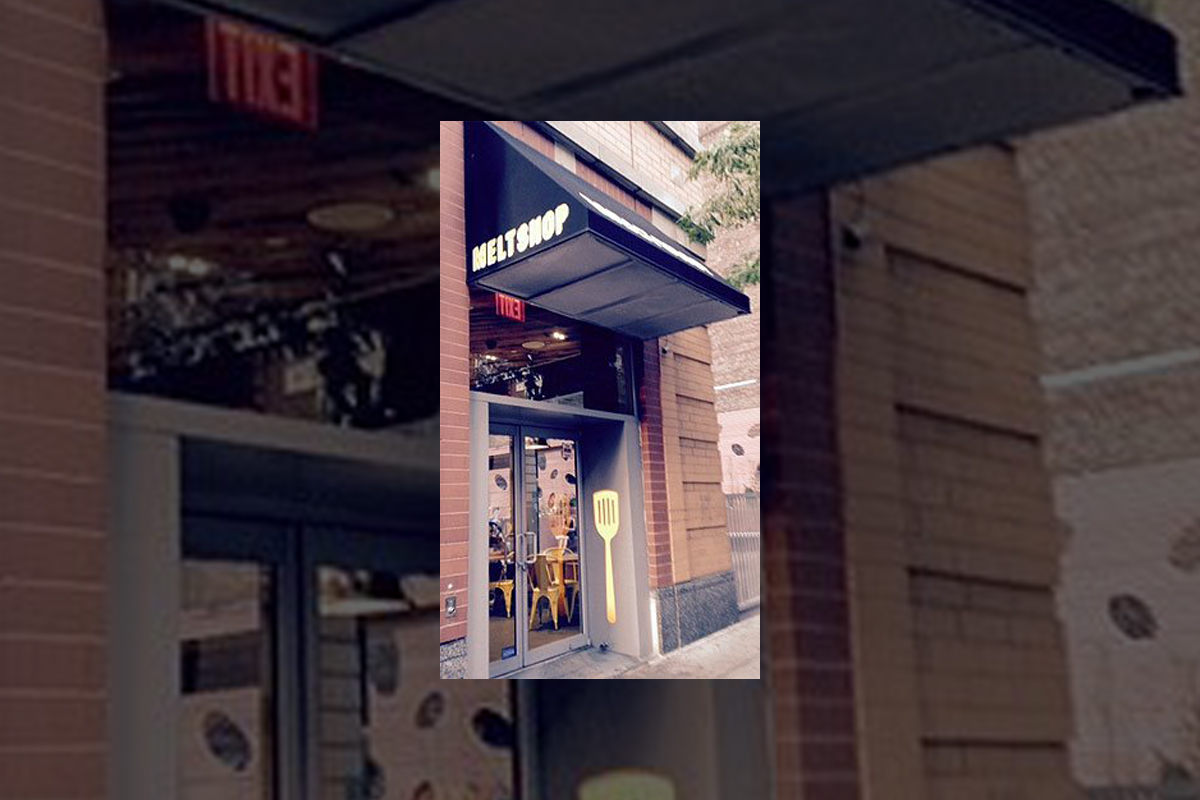
Greetings from NYC. Nancy and I drove down from New
Hampshire yesterday because we'll be checking out
Disney Consumer Products' annual Holiday Showcase later today.
Anyway … After checking into our hotel (i.e., The Paul.
Which is located down in NYC's NoMad district), we decided to grab some dinner.
Which is how we wound up at the Melt Shop.

Photo by Jim Hill
Which is this restaurant that only sells grilled cheese sandwiches.
This comfort food was delicious, but kind of on the heavy side.

Photo by Jim Hill
Which is why — given that it was a beautiful summer night
— we'd then try and walk off our meals. We started our stroll down by the Empire
State Building
…
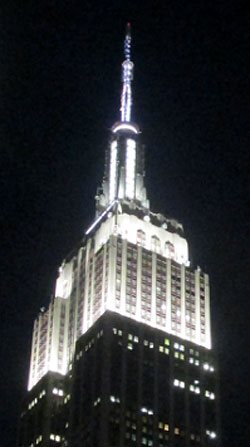
Photo by Jim Hill
… and eventually wound up just below Times
Square (right behind where the Waterford Crystal Times Square New
Year's Eve Ball is kept).
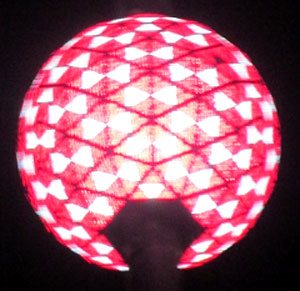
Photo by Jim Hill
But you know what we discovered en route? Right in the heart
of Manhattan's Garment District
along Broadway between 36th and 41st? This incredibly cool series of life-like
and life-sized sculptures that Seward
Johnson has created.
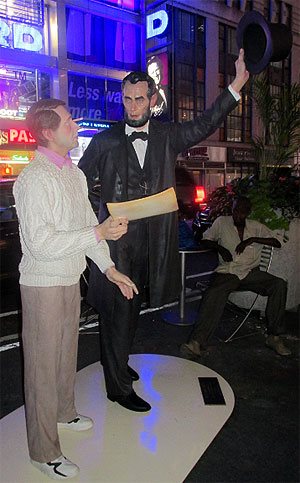
Photo by Jim Hill
And — yes — that is Abraham Lincoln (who seems to have
slipped out of WDW's Hall of Presidents when no one was looking and is now
leading tourists around Times Square). These 18 painted
bronze pieces (which were just installed late this past Sunday night / early
Monday morning) range from the surreal to the all-too-real.

Photo by Jim Hill
Some of these pieces look like typical New Yorkers. Like the
business woman planning out her day …
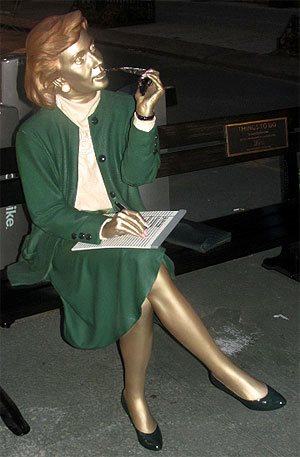
Photo by Jim Hill
… the postman delivering the mail …
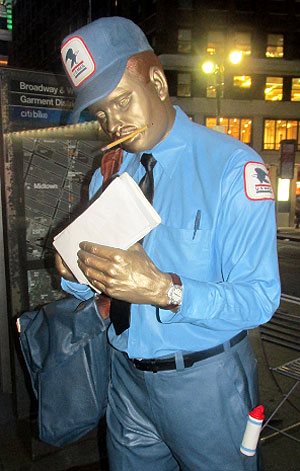
Photo by Jim Hill
… the hot dog vendor working at his cart …
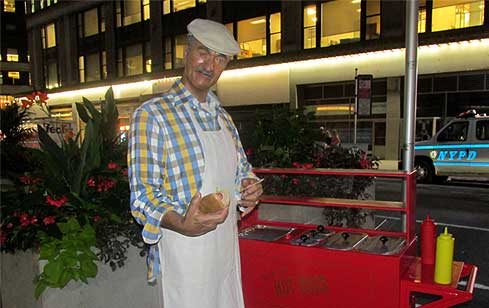
Photo by Jim Hill

Photo by Jim Hill
… the street musician playing for tourists …
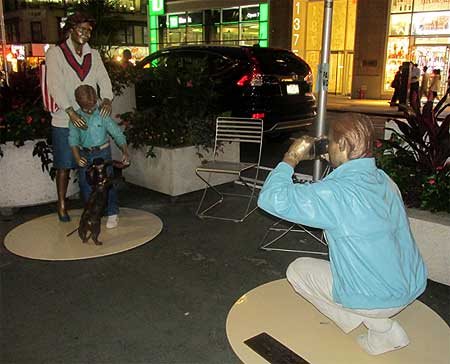
Photo by Jim Hill
Not to mention the tourists themselves.

Photo by Jim Hill
But right alongside the bronze businessmen …
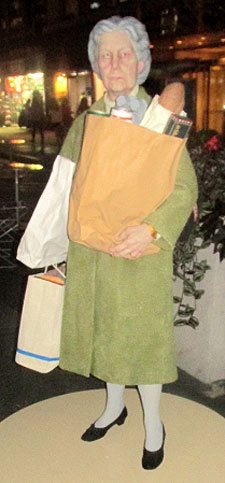
Photo by Jim Hill
… and the tired grandmother hauling her groceries home …
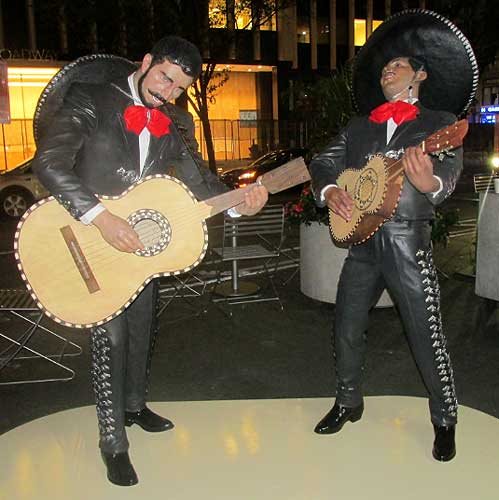
Photo by Jim Hill
… there were also statues representing people who were
from out-of-town …

Photo by Jim Hill
… or — for that matter — out-of-time.
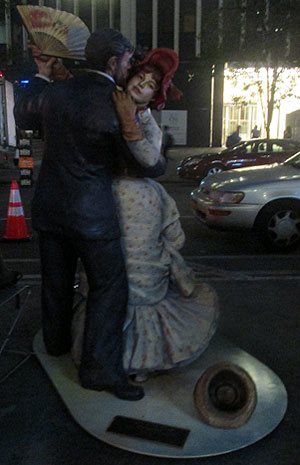
Photo by Jim Hill
These were the Seward Johnson pieces that genuinely beguiled. Famous impressionist paintings brought to life in three dimensions.
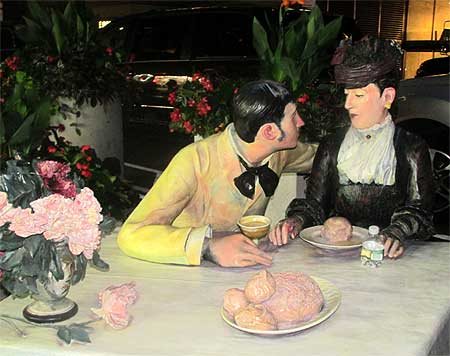
Note the out-of-period water bottle that some tourist left
behind. Photo by Jim Hill
Some of them so lifelike that you actually had to pause for
a moment (especially as day gave way to night in the city) and say to yourself
"Is that one of the bronzes? Or just someone pretending to be one of these
bronzes?"
Mind you, for those of you who aren't big fans of the
impressionists …
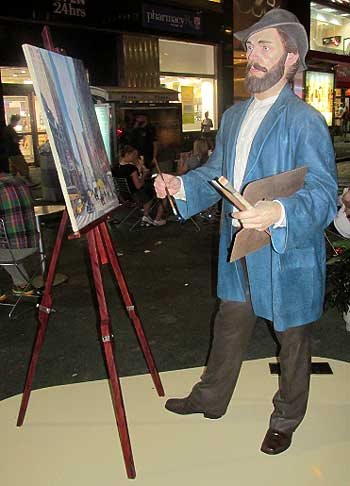
Photo by Jim Hill
… there's also an array of American icons. Among them
Marilyn Monroe …
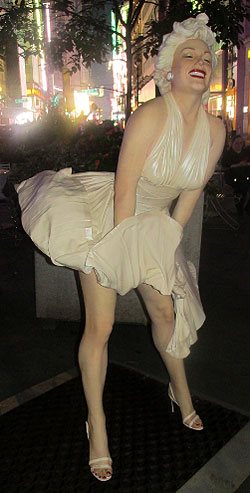
Photo by Jim Hill
… and that farmer couple from Grant Wood's "American
Gothic."
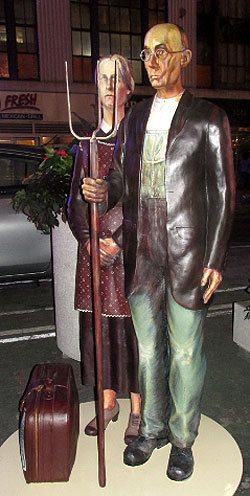
Photo by Jim Hill
But for those of you who know your NYC history, it's hard to
beat that piece which recreates Alfred Eisenstaedt's famous photograph of V-J Day in Times Square.
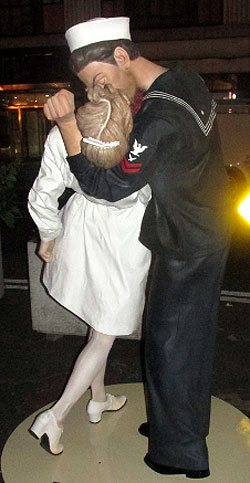
Photo by Jim Hill
By the way, a 25-foot-tall version of this particular Seward
Johnson piece ( which — FYI — is entitled "Embracing Peace") will actually
be placed in Times Square for a few days on or around August 14th to commemorate the 70th
anniversary of Victory Over Japan Day (V-J Day).

Photo by Jim Hill
By the way, if you'd like to check these Seward Johnson bronzes in
person (which — it should be noted — are part of the part of the Garment
District Alliance's new public art offering) — you'd best schedule a trip to
the City sometime over the next three months. For these pieces will only be on
display now through September 15th.
General
Wondering what you should “Boldly Go” see at the movies next year? The 2015 Licensing Expo offers you some clues

Greeting from the 2015 Licensing Expo, which is being held
at the Mandalay Bay
Convention Center in Las
Vegas.
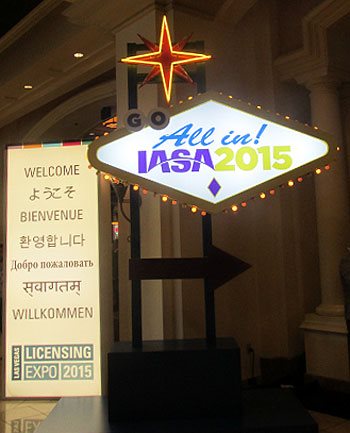
Photo by Jim Hill
I have to admit that I enjoy covering the Licensing Expo.
Mostly becomes it allows bloggers & entertainment writers like myself to
get a peek over the horizon. Scope out some of the major motion pictures &
TV shows that today's vertically integrated entertainment conglomerates
(Remember when these companies used to be called movie studios?) will be
sending our way over the next two years or so.
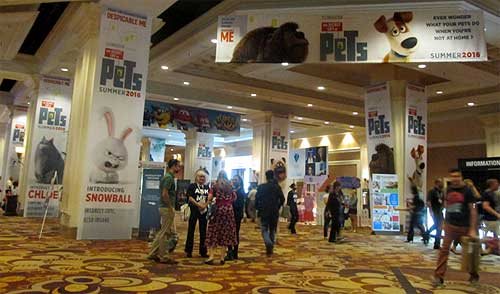
Photo by Jim Hill
Take — for example — all of "The Secret Life of
Pets" banners that greeted Expo attendees as they made their way to the
show floor today. I actually got to see some footage from this new Illumination
Entertainment production (which will hit theaters on July 8, 2016) the last time I was in Vegas. Which
was for CinemaCon back in April. And the five or so minutes of film that I viewed
suggested that "The Secret Life of Pets" will be a really funny
animated feature.
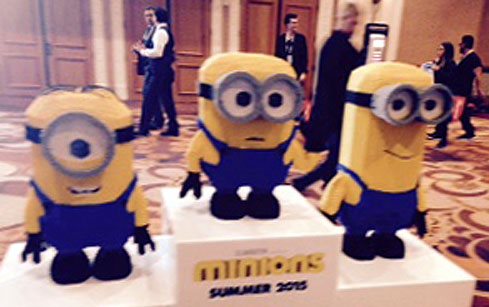
Photo by Jim Hill
Mind you, Universal Pictures wanted to make sure that Expo
attendees remembered that there was another Illumination Entertainment production
coming-to-a-theater-near-them before "The Secret Life of Pets" (And
that's "Minions," the "Despicable Me" prequel. Which
premieres at the Annecy International Animated Film Festival next week but
won't be screened stateside 'til July 10th of this year). Which is why they had
three minions who were made entirely out of LEGOS loitering out in the lobby.
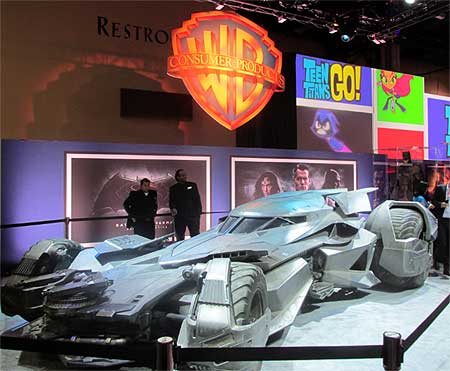
Photo by Jim Hill
And Warner Bros. — because they wanted "Batman v
Superman: Dawn of Justice" to start trending on Twitter today — brought
the Batmobile to Las Vegas.
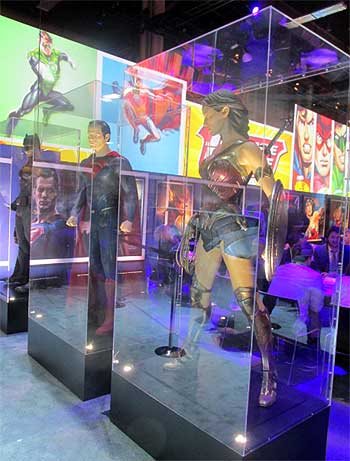
Photo by Jim Hill
Not to mention full-sized macquettes of Batman, Superman and
Wonder Woman. Just so conventioneers could then see what these DC superheroes
would actually look like in this eagerly anticipated, March 25, 2016 release.
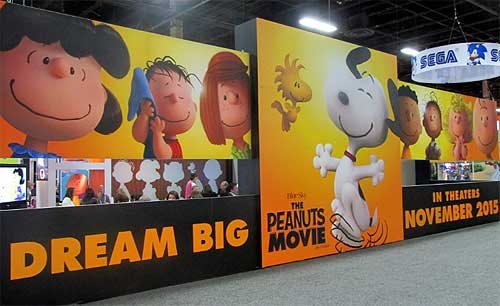
Photo by Jim Hill
That's the thing that can sometimes be a wee bit frustrating
about the Licensing Expo. It's all about delayed gratification. You'll come
around a corner and see this 100 foot-long ad for "The Peanuts Movie"
and think "Hey, that looks great. I want to see that Blue Sky Studios production
right now." It's only then that you notice the fine print and realize that
"The Peanuts Movie" doesn't actually open in theaters 'til November
6th of this year.
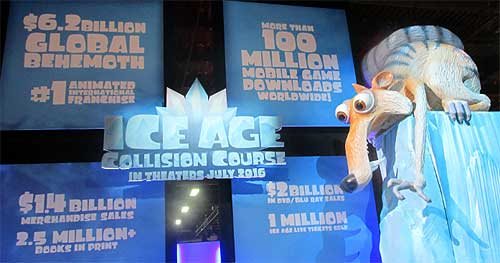
Photo by Jim Hill
And fan of Blue Sky's "Ice Age" film franchise are in for an even
longer wait. Given that the latest installment in that top grossing series
doesn't arrive in theaters 'til July
15, 2016.
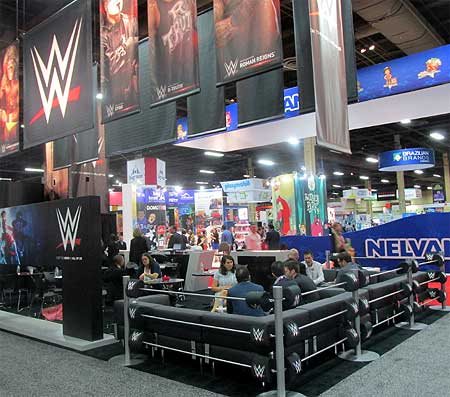
Photo by Jim Hill
Of course, if you're one of those people who needs immediate
gratification when it comes to your entertainment, there was stuff like that to
be found at this year's Licensing Expo. Take — for example — how the WWE
booth was actually shaped like a wrestling ring. Which — I'm guessing — meant
that if the executives of World Wrestling Entertainment, Inc. didn't like
the offer that you were making, they were then allowed to toss you out over the
top rope, Royal Rumble-style.

Photo by Jim Hill
I also have to admit that — as a longtime Star Trek fan —
it was cool to see the enormous Starship Enterprise that hung in place over the
CBS booth. Not to mention getting a glimpse of the official Star Trek 50th
Anniversary logo.
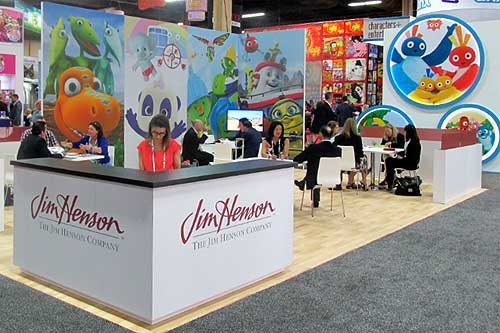
Photo by Jim Hill
I was also pleased to see lots of activity in The Jim Henson
Company booth. Which suggests that JHC has actually finally carved out a
post-Muppets identity for itself.
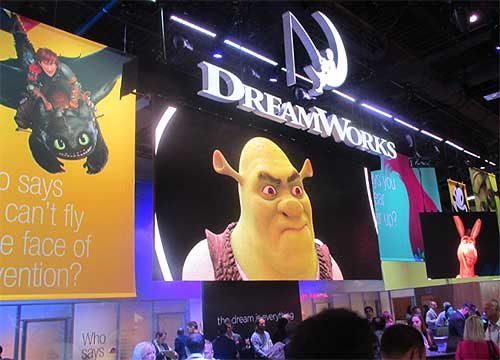
Photo by Jim Hill
Likewise for all of us who were getting a little concerned
about DreamWorks Animation (what with all the layoffs & write-downs &
projects that were put into turnaround or outright cancelled last year), it was
nice to see that booth bustling.
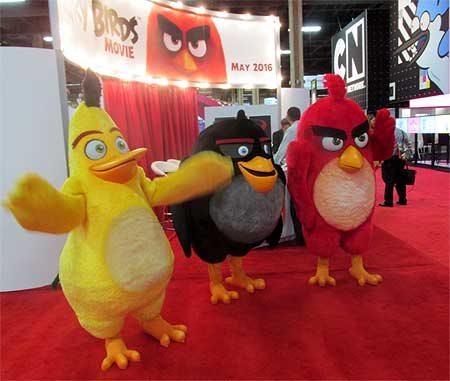
Photo by Jim Hill
Every so often, you'd come across some people who were
promoting a movie that you weren't entirely sure that you actually wanted to
see (EX: "Angry Birds," which Sony Pictures Entertainment / Columbia
Pictures will be releasing to theaters on May 20, 2016). But then you remembered that Clay Kaytis —
who's this hugely talented former Walt Disney Animation Studios animator — is
riding herd on "Angry Birds" with Fergal Reilly. And you'd think
"Well, if Clay's working on 'Angry Birds,' I'm sure this animated feature
will turn out fine."
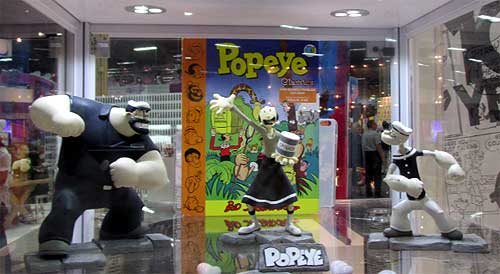
Photo by Jim Hill
Mind you, there were reminders at this year's Licensing Expo
of great animated features that we're never going to get to see now. I still
can't believe — especially after that brilliant proof-of-concept footage
popped up online last year — that Sony execs decided not to go forward
with production of Genndy Tartakovsky's
"Popeye" movie. But that's the
cruel thing about the entertainment business, folks. It will sometime break
your heart.
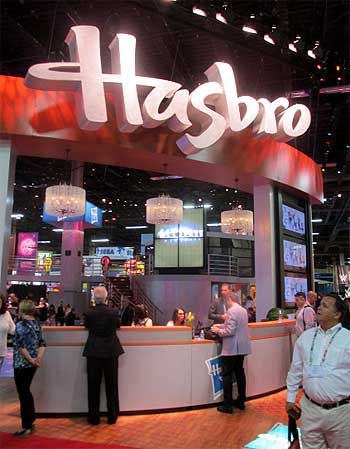
Photo by Jim Hill
And make no mistake about this. The Licensing Expo is all
about business. That point was clearly driven home at this year's show when —
as you walked through the doors of the Mandalay
Bay Convention Center
— the first thing that you saw was the Hasbros Booth. Which was this gleaming,
sleek two story-tall affair full of people who were negotiating deals &
signing contracts for all of the would-be summer blockbusters that have already
announced release dates for 2019 & beyond.
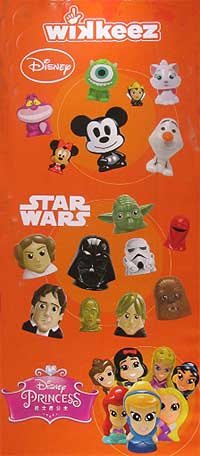
Photo by Jim Hill
"But what about The Walt Disney Company?," you
ask. "Weren't they represented on the show floor at this year's Licensing
Expo?" Not really, not. I mean, sure. There were a few companies there hyping
Disney-related products. Take — for example — the Disney Wikkeez people.
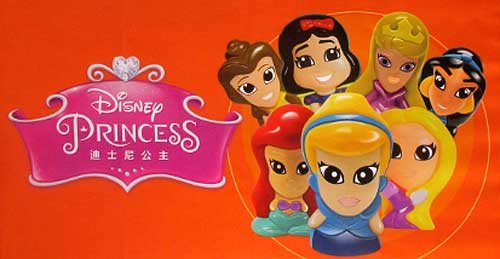
Photo by Jim Hill
I'm assuming that some Disney Consumer Products exec is
hoping that Wikkeez will eventually become the new Tsum Tsum. But to be blunt,
these little hard plastic figures don't seem to have the same huggable charm
that those stackable plush do. But I've been wrong before. So let's see what
happens with Disney Wikkeez once they start showing up on the shelves of the
Company's North American retail partners.

Photo by Jim Hill
And speaking of Disney's retail partners … They were
meeting with Mouse House executives behind closed doors one floor down from the
official show floor for this year's Licensing Expo.
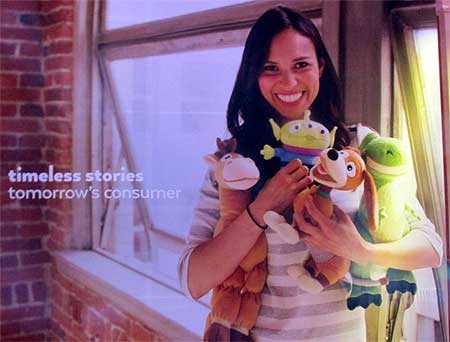
Photo by Jim Hill
And the theme for this year's invitation-only Disney shindig? "Timeless
Stories" involving the Disney, Pixar, Marvel & Lucasfilm brands that
would then appeal to "tomorrow's consumer."

Photo by Jim Hill
And just to sort of hammer home the idea that Disney is no
longer the Company which cornered the market when it comes to little girls
(i.e., its Disney Princess and Disney Fairies franchises), check out this
wall-sized Star Wars-related image that DCP put up just outside of one of its
many private meeting rooms. "See?," this carefully crafted photo
screams. "It isn't just little boys who want to wield the Force. Little
girls also want to grow up and be Lords of the Sith."
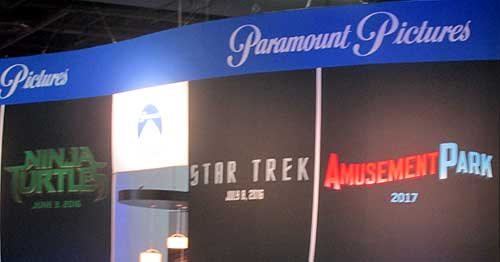
Photo by Jim Hill
One final, kind-of-ironic note: According to this banner,
Paramount Pictures will be releasing a movie called "Amusement Park"
to theaters sometime in 2017.
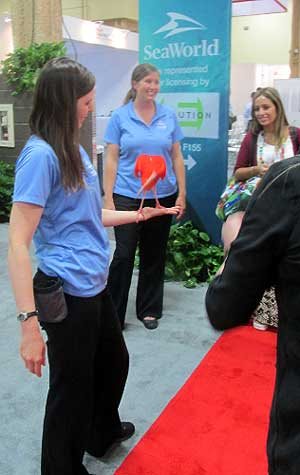
Photo by Jim Hill
Well, given all the "Blackfish" -related issues
that have been dogged SeaWorld Parks & Entertainment over the past two years, I'm
just hoping that they'll still be in the amusement park business come 2017.
Your thoughts?
General
It takes more than three circles to craft a Classic version of Mickey Mouse
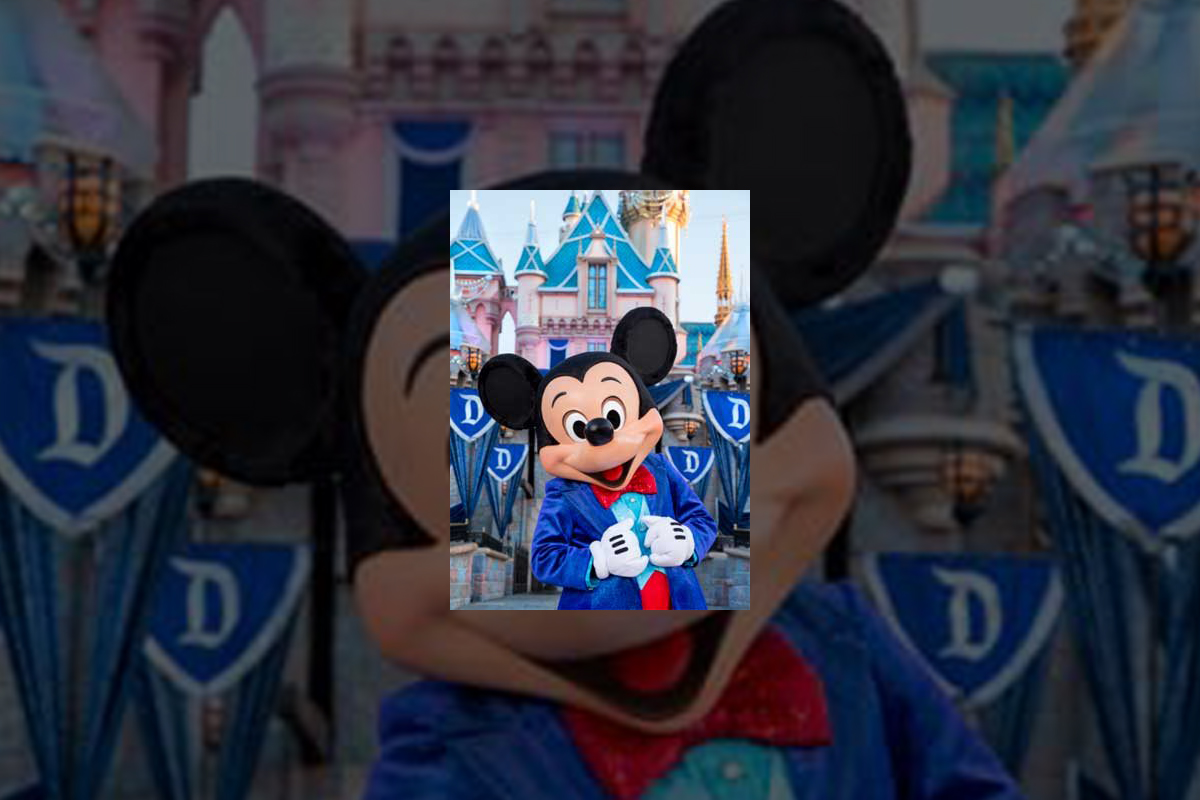
You know what Mickey Mouse looks like, right? Little guy,
big ears?
Truth be told, Disney's corporate symbol has a lot of
different looks. If Mickey's interacting with Guests at Disneyland
Park (especially this summer, when
the Happiest Place on Earth
is celebrating its 60th anniversary), he looks & dresses like this.
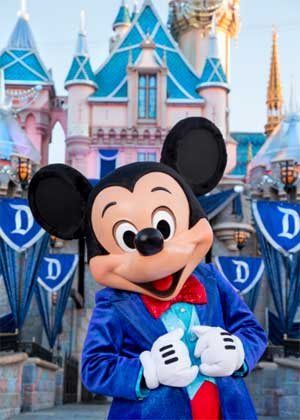
Copyright Disney Enterprises,
Inc.
All rights reserved
Or when he's appearing in one of those Emmy Award-winning shorts that Disney
Television Animation has produced (EX: "Bronco Busted," which debuts
on the Disney Channel tonight at 8 p.m. ET / PT), Mickey is drawn in a such a
way that he looks hip, cool, edgy & retro all at the same time.
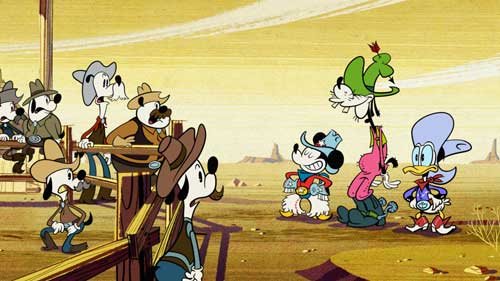
Copyright Disney Enterprises, Inc. All rights
reserved
Looking ahead to 2017 now, when Disney Junior rolls out "Mickey and the
Roadster Racers," this brand-new animated series will feature a sportier version
of Disney's corporate symbol. One that Mouse House managers hope will persuade
preschool boys to more fully embrace this now 86 year-old character.

Copyright Disney Enterprises,
Inc. All rights reserved
That's what most people don't realize about the Mouse. The
Walt Disney Company deliberately tailors Mickey's look, even his style of
movement, depending on what sort of project / production he's appearing in.
Take — for example — Disney
California Adventure
Park's "World of Color:
Celebrate!" Because Disney's main mouse would be co-hosting this new
nighttime lagoon show with ace emcee Neil Patrick Harris, Eric Goldberg really had
to step up Mickey's game. Which is why this master Disney animator created
several minutes of all-new Mouse animation which then showed that Mickey was
just as skilled a showman as Neil was.
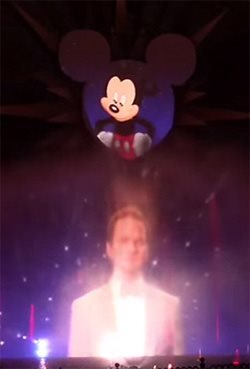
Copyright Disney Enterprises,
Inc.
All rights reserved
Better yet, let's take a look at what the folks at Avalanche Studios just went
through as they attempted to create a Classic version of Mickey & Minnie.
One that would then allow this popular pair to become part of Disney Infinity
3.0.
"I won't lie to you. We were under a lot of pressure to
get the look of this particular version of Mickey — he's called Red Pants
Mickey around here — just right," said Jeff Bunker, the VP of Art
Development at Avalanche Studios, during a recent phone interview. "When
we brought Sorcerer Mickey into Disney Infinity 1.0 back in January of 2014,
that one was relatively easy because … Well, everyone knows what Mickey Mouse
looked like when he appeared in 'Fantasia.' "
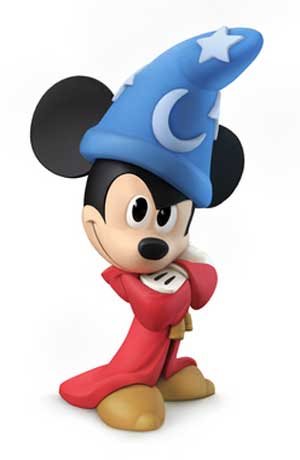
Copyright Disney Enterprises,
Inc. All rights reserved
"But this time around, we were being asked to design
THE Mickey & Minnie," Bunker continued. "And given that these Classic
Disney characters have been around in various different forms for the better
part of the last century … Well, which look was the right look?"
Which is why Jeff and his team at Avalanche Studios began watching hours &
hours of Mickey Mouse shorts. As they tried to get a handle on which look would
work best for these characters in Disney Infinity 3.0.
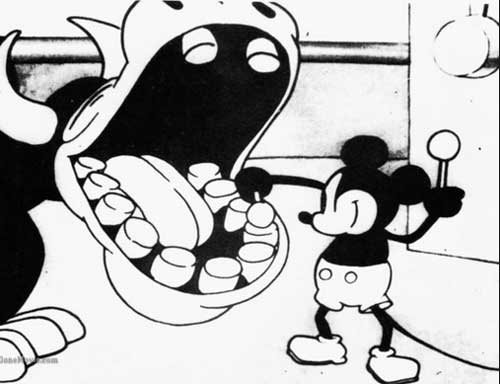
Copyright Disney
Enterprises, Inc. All rights reserved
"And we went all the way back to the very start of Mickey's career. We began
with 'Steamboat Willie' and then watched all of those black & white Mickey shorts
that Walt made back in the late 1920s & early 1930s. From there, we
transitioned to his Technicolor shorts. Which is when Mickey went from being
this pie-eyed, really feisty character to more of a well-behaved leading
man," Bunker recalled. "We then finished out our Mouse marathon by
watching all of those new Mickey shorts that Paul Rudish & his team have
been creating for Disney Television Animation. Those cartoons really recapture
a lot of the spirit and wild slapstick fun that Mickey's early, black &
white shorts had."
But given that the specific assignment that Avalanche Studios had been handed
was to create the most appealing looking, likeable version of Mickey Mouse
possible … In the end, Jeff and his team wound up borrowing bits & pieces
from a lot of different versions of the world's most famous mouse. So that
Classic Mickey would then look & move in a way that best fit the sort of
gameplay which people would soon be able to experience with Disney Infinity
3.0.
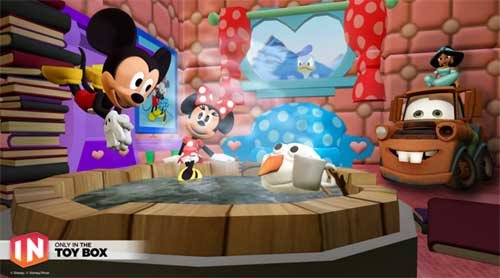
Copyright Disney Enterprises,
Inc. All rights reserved
"That — in a lot of ways — was actually the toughest
part of the Classic Mickey design project. You have to remember that one of the
key creative conceits of Disney Infinity
is that all the characters which appear in this game are toys," Bunker
stated. "Okay. So they're beautifully detailed, highly stylized toy
versions of beloved Disney, Pixar, Marvel & Lucasfilm characters. But
they're still supposed to be toys. So our Classic versions of Mickey &
Minnie have the same sort of thickness & sturdiness to them that toys have.
So that they'll then be able to fit right in with all of the rest of the
characters that Avalanche Studios had previously designed for Disney Infinity."
And then there was the matter of coming up with just the
right pose for Classic Mickey & Minnie. Which — to hear Jeff tell the
story — involved input from a lot of Disney upper management.

Copyright Disney Enterprises,
Inc. All rights reserved
"Everyone within the Company seemed to have an opinion
about how Mickey & Minnie should be posed. More to the point, if you Google
Mickey, you then discover that there are literally thousands of poses out there
for these two. Though — truth be told — a lot of those kind of play off the
way Mickey poses when he's being Disney's corporate symbol," Bunker said.
"But what I was most concerned about was that Mickey's pose had to work
with Minnie's pose. Because we were bringing the Classic versions of these
characters up into Disney Infinity 3.0 at the exact same time. And we wanted to
make sure — especially for those fans who like to put their Disney Infinity
figures on display — that Mickey's pose would then complement Minnie.
Which is why Jeff & the crew at Avalanche Studios
decided — when it came to Classic Mickey & Minnie's pose — that they
should go all the way back to the beginning. Which is why these two Disney icons
are sculpted in such a way that it almost seems as though you're witnessing the
very first time Mickey set eyes on Minnie.

Copyright Disney Enterprises,
Inc. All rights reserved
"And what was really great about that was — as soon as
we began showing people within the Company this pose — everyone at Disney
quickly got on board with the idea. I mean, the Classic Mickey that we sculpted
for Disney Infinity 3.0 is clearly a very playful, spunky character. But at the
same time, he's obviously got eyes for Minnie," Bunker concluded. "So
in the end, we were able to come up with Classic versions of these characters
that will work well within the creative confines of Disney Infinity 3.0 but at
the same time please those Disney fans who just collect these figures because
they like the way the Disney Infinity characters look."
So now that this particular design project is over, does
Jeff regret that Mouse House upper management was so hands-on when it came to
making sure that the Classic versions of Mickey & Minnie were specifically
tailored to fit the look & style of gameplay found in Disney Infinity 3.0?
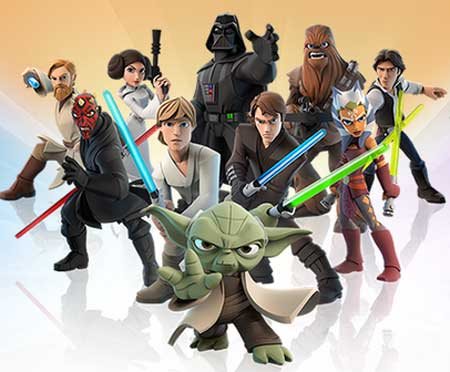
Copyright Lucasfilm / Disney
Enterprises, Inc. All rights reserved
"To be blunt, we go through this every time we add a new character to the
game. The folks at Lucasfilm were just as hands-on when we were designing the
versions of Darth Vader and Yoda that will also soon be appearing in Disney
Infinity 3.0," Bunker laughed. "So in the end, if the character's
creators AND the fans are happy, then I'm happy."
This article was originally posted on the Huffington Post's Entertainment page on Tuesday, June 9, 2015
-

 Theme Parks & Themed Entertainment8 months ago
Theme Parks & Themed Entertainment8 months agoDisney’s Forgotten Halloween Event: The Original Little Monsters on Main Street
-

 Theme Parks & Themed Entertainment8 months ago
Theme Parks & Themed Entertainment8 months agoThe Story of Mickey’s Not-So-Scary Halloween Party: From One Night to a Halloween Family Tradition
-

 Film & Movies8 months ago
Film & Movies8 months agoHow “An American Tail” Led to Disney’s “Hocus Pocus”
-

 Theme Parks & Themed Entertainment6 months ago
Theme Parks & Themed Entertainment6 months agoDisney and Macy’s 90-Year Thanksgiving Day Parade Partnership: From Mickey’s First Balloon to Minnie’s Big Debut
-

 Television & Shows4 months ago
Television & Shows4 months agoHow the Creators of South Park Tricked A-List Celebrities to Roast Universal – “Your Studio & You”
-

 History3 months ago
History3 months agoThe Super Bowl & Disney: The Untold Story Behind ‘I’m Going to Disneyland!’
-

 Podcast1 month ago
Podcast1 month agoEpic Universal Podcast – Aztec Dancers, Mariachis, Tequila, and Ceremonial Sacrifices?! (Ep. 45)
-

 Television & Shows3 weeks ago
Television & Shows3 weeks agoThe Untold Story of Super Soap Weekend at Disney-MGM Studios: How Daytime TV Took Over the Parks






